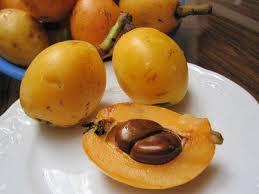Although loquats are not
popular in many countries, they are beloved fruits in China and Japan. In these
cultures, legends and mythology surround its origins. For example, Chinese lore
holds that loquats stemmed from the base of a waterfall. When a carp ate the
fruit, it transformed into a dragon. The royal family, seeing the miraculous
powers of the fruit, forbade anyone but the family from eating loquats.
Origin of Loquat
According
to the Encyclopedia of Fruit and Nuts, the fruit was brought from Japan to
China, although others contend that it’s the other way around. Records show
that the fruits were present on Japan’s soils as early as 1100AD. Etymology
complicates the debate: The Japanese used to call loquats with a name
resembling its Chinese term, “biwa;” indeed, during the Tang Dynasty from 618
to 907, loquats were called “Tang biwa.”
The
fruit spread to other countries by way of German physician and botanist
Engelbert Kaempfer, who recorded his loquat sightings in Japan in his book,
Amoenitatum Exoticarum in 1712. By 1784, loquats were sent to gardens in Paris
and, a year later, in London. After loquat’s arrival in these key cities, the
fruit spread to the Mediterranean and parts of Northern Africa.
Though
Loquats are naturalized in India, how the fruit ultimately came to its soils is
a mystery. Most sources claim that the fruit didn’t arrive until long after the
US had received it around 1870; however, the 1857 publication, “India Under the
British Empire,” references loquat as already being present. Given
Afghanistan’s long-standing love affair with the fruit, perhaps loquats arrived
by way of the Muslim rulers in the north.
Today,
China continues its strong interest in loquats, and the country grows over 100
varieties within its borders. According to a 2003 report published by the
International Centre for Advanced Mediterranean Agronomic Studies, China
produces the most fruits in the world, followed by Japan, Pakistan, Israel and
Egypt. The most important cultivars are Tanaka, Algene, and Golden Nugget.
Availability of Loquat in India
A Purdue horticulture
article explains that at least 14 varieties of loquat are cultivated in India:
all vary in their quality, size, shape, acidity, sweetness, flesh consistency
and toughness of skin. The poorer quality fruits sell for jam and preserve
processing, while the higher qualities get transported fresh. The trees grow up
to 5,000 ft. in elevation all over India.
Some of the regions
cultivating loquats are Uttar Pradesh, Delhi, Punjab, Himachal Pradesh, Assam,
Maharashtra, and a few of the hill stations in the south.
Loquat season in India is
in the spring, beginning in mid-March and lasting through May.
Where to find Loquat in India
Because loquat is one of
the only fruits in season during this time of year, many vendors purvey the
fruit. They are easily found during the spring and early summer months in shops
large and small.
Checking for Ripeness in Loquat
Loquats are aromatic when
ripe, possessing a fruity, distinct smell. Though the Japanese sell very
carefully wrapped white loquats free of blemishes, Indian loquats sold in the
dusty markets tend to be mottled. Do not let these marks be a deterrent: like
mangos, sometimes the spotted ones are the sweetest. Steer clear of green
loquats, as they are under ripe and thus quite acidic. Also avoid fruits with
cuts, wrinkles, or small pit marks. A good loquat should have the stem still
attached to the fruit, as removing it hastens decay.
Do not use color as a
gauge of ripeness, as it varies depending on the cultivar. Some fruits are
white, others golden, and some loquats are reddish orange. Go by feel and scent
instead—opt for a floral aroma with hints of apricot and cherry, and pick
smooth-skinned loquats that give slightly to the touch.
Taste of Loquat
Loquats
vary in texture, but the ideal dessert fruits have pulpy, juicy sweet flesh
reminiscent of peach and apricot’s floral sweetness, and persimmon’s mildness.
As its other name, “Japanese plum” suggests, the taste is a mix of plum, peach,
and apricot. Loquats are not acidic, nor are they sour except some of the pulp
near the bottom. Some describe loquat like a pear, but with a tropical taste
resembling a mango. Others are unimpressed by the fruit’s mellow, understated
simplicity.
The
fruit’s texture is firmer than a pulpy apricot, and better resembles a plum’s.
When
cooked, the sugars concentrate, and loquat’s taste becomes similar to a fig’s.
If
underripe, however, loquats taste sour and hard.
Nutritional Value of Loquat
According
to the USDA nutrient database, the nutritional analysis per 100g of edible
loquat is:
47kcal
43.9g
Carb (4% RDI)
1.7g
Fiber (7% RDI)
1528IU
Vitamin A (31% RDI)
1mg
Vitamin C (2% RDI)
.1mg
Vitamin B6 (5% RDI)
14mg
Folate (3% RDI)
16mg
Calcium (2% RDI)
.3mg
Iron (2% RDI)
13mg
Magnesium (3% RDI)
27mg
Phosphorous (3% RDI)
266mg
Potassium (8% RDI)
Copper
(2% RDI)
.1mg
Manganese (7% RDI)
Health Benefits of Loquat
According to the book,
“Ayurvedic Curative Cuisine for Everyone,” loquat fruits positively affect the
endocrine system, digestive, immune and respiratory system. Loquats are also
used for their sedative properties ability to halt vomiting.
Traditional Chinese
medicine affirms many of Ayurveda’s teachings: in the book, “Ancient Wisdom,
Modern Kitchen,” loquat fruit moistens lungs, reduces coughing, quenches thirst
and eases stomach problems such as nausea. The book goes on to tout the leaves’
ability to remedy heat problems such as excess sweating and fever. The leaves
also treat spleen issues, including diarrhea. Even today, China sells loquat
syrup to remedy coughs and sore throats.
Many scientific studies
report promising findings on loquat’s medicinal potential:
--A study by scientists
in Jordan published in BMC Complementary
and Alternative Medicine found that loquat extracts has potential for use
in cancer therapies due to its
cytokine immunomodulation capabilities.
--A study published in
the Food and Chemical Toxicology
reports that loquat extracts offer considerable protection against memory impairment and neurological
oxidative stress.
--The Journal of Ethnopharmacology published a
report touting loquat leaf’s significant anti-inflammatory
and analgesic qualities.
--A study published by
the Phytotherapy Research states that
loquats are a functional food for the prevention of diabetes and hyperlipidemia.
--The Archives of Pharmaceutical Research
published a study stating the loquat’s leaves may be a valuable agent in the
treatment of cancer metastasis.
--According to a study in
The Journal of Natural Medicines,
leaf extracts of loquat may protect the body against cellular aging.
How to Open/Cut:
Though the peel is
edible—and should stay intact if preserving—most choose to peel the skin to expose
loquat’s soft, fleshy pulp. One of the easiest ways to remove the skin is by
blanching, or, boiling for only a few minutes. When taken off the stove, the
fruits should peel easily. 2-3 large brown, glossy seeds in the center of the
fruit require removal. Like other stone fruits, their seeds contain small
amounts of arsenic.
If preparing many loquats
for use in a recipe, dedicate ample time to the project: deseeding the
grape-sized fruit is a laborious undertaking.
 |
| Loquat pie from wildedibletexas.com |
Storage:
Loquats do not have to be
stored in the refrigerator, but they should be placed in a cool area. In these
conditions, will keep for ten days at room temperature. If the kitchen is
notoriously warm and humid, opt for the fridge. In cool storage, loquats keep
for almost a month.
Loquat Recipe Ideas and Uses:
--Make a preserve and use to top pancakes,
cakes, ice cream and pastries. Because loquats have such a mild flavor,
consider supplementing them with additional spices, such as cinnamon, clove or
cardamom. Also, though loquats have some pectin, add more to improve the
preserve’s consistency.
--Use in ice cream, but use supplementary spices
to enhance loquat’s subdued flavor. Though loquats go well with warm spices,
they can also pair with bright, cool flavors like mint and lemon.
--Like apricots and
peach, cut, peeled loquats make a beautiful addition to tarts.
--Swirl into creamy batters for breads, yoghurts or
cheesecakes: the fruit pairs beautifully with cheese and cheese-like flavors.
--Add loquats as a
rambutan or lychee substitute in any Chinese cooking dish.
--Make loquat syrup by stewing the peeled, seeded
fruit puree in sugar and water, reducing the concoction into a syrupy broth.
Add vanilla and a pinch of salt.
--Bake loquats with nuts,
sugar, garlic and onions, and serve atop rice and grain dishes such as tagine, biryani, and couscous. Baking does not require
peeling the fruit.
--Poach the fruit with sugar and a cinnamon stick
--Add loquat to salsa recipes
--Make loquat soda by first peeling loquats and deseeding
them. Use a juicer to extract the pulp and juice, and then boil with sugar.
Strain the concoction through cheesecloth, and refrigerate. Add carbonated
water and ice. Note: if desiring a more tart, tangy flavor, leave the skins on
some of the fruits.
 |
| Loquat salsa from Annieinaustin.blogspot.com |
Flavor Complements:
Passion fruit, apricot,
pear, prickly pear, lychee, peach, plum, strawberry, cherry, persimmon, quince
Spices: basil, mint,
cinnamon, vanilla, lavender, cardamom, nutmeg, clove, walnuts, pecans
Random Facts:
In Ancient China, some
brothels were called “the gate of the loquats.”
Scientific Name:
Eriobotrya japonica
Other Names:
Japanese medlar
Japanese plum
Nespole (Italian)
Biwa (Japanese)
Related Fruits:
Loquats
are part of the pome family, and are thus related to pears, quinces and apples.












Loquats do not have to be saved in the refrigerator, but they should be placed in a awesome area. If the kitchen is infamously warm and moist, opt for the refrigerator. Loquats keep for four to five days. The fruits and veggies are extremely disposable.
ReplyDeleteRunescape 2007 Gold
How do I get in touch with you? Have a few questions
ReplyDeleteWhere can I get planting material or seeds of Loquat?
ReplyDeleteDo you know any one selling plants or has Loquat?
Where can I get good quality Loquat Saplings in India for my home garden?
ReplyDeleteWhere can I get good quality Loquat Saplings in India for my home garden? Please email your reply to prasad_grr@yahoo.com
ReplyDeleteThe loquat is a species of flowering plant in the family Rosaceae, native to south-central China ,Pakistan and Kashmir. It is a large evergreen shrub or small tree, grown commercially for its tasty yellow fruit, and also cultivated as an ornamental plant.
DeleteThe loquat is adapted to a subtropical to mild-temperate climate. In Kashmir it grows naturally at altitudes between 2,000 and 3,000 ft .
Seedlings of loukot are available at Jammu and Kashmir Medicinal Plants Introduction Centre
More details: http://jkmpic.blogspot.in
Thank you for sharing the nice information! It's a good chance to know more about these stories, very interesting and meaningful. And please take a look at this site, where I find the all the information I need about celeb networth
ReplyDeleteGreat read thankyyou
ReplyDeleteYour comment is very beneficial for the future, you have written in a very beautiful way, you have an inspiration for the youth who come to your comment is really very beautiful, nowadays children do not know where they are wandering, no one can make a comment like you. The post is very different. gurugram Girl phone number
ReplyDeletegurugram girl content number
Bhiwadi Real Photos Girl
Manesar VIP Photos Girl
Gurugram hell girl
DLF Phase 3 premium girl
college girl gurgaon
beautiful Girl Gurgaon
online girl gurgaon
Great and helpful article.
ReplyDelete
ReplyDeleteMy name is Salu from Kolkata. Anyone meet me for fun and pleasure?
Thanks so much for the blog post its very informative and I commend you for that
ReplyDeleteI enjoyed over study your weblog post.
ReplyDeleteBeen searching for simple article like this. Thanks to your writing
ReplyDelete